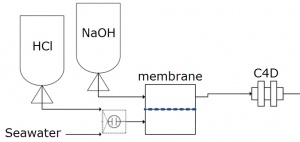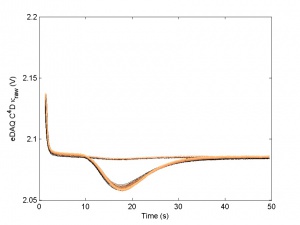Measuring Total Dissolved Inorganic Carbon of Seawater using Flow Injection Analysis and C4D
Introduction
The eDAQ C4D was used by the Scripps Institution of Oceanography to measure total dissolved inorganic carbon (TCO2 or DIC) of seawater using a flow injection analysis method. The device developed at Scripps will ultimately be used on autonomous platforms in order to continuously and remotely observe the ocean carbon cycle.
This original research was conducted by Phil Bresnahan and Todd Martz at the Scripps Institution of Oceanography in La Jolla, USA. See their research paper on “Gas Diffusion Cell Geometry for a Microfluidic Dissolved Inorganic Carbon Analyzer”.
Autonomous Measurement
The measurement of total dissolved inorganic carbon is made on discrete, sub-millilitre seawater samples. The procedure is shown in Figure 1. The seawater sample is mixed with a small dose of hydrochloric acid (HCl) to force all the dissolved inorganic carbon into the carbon dioxide (CO2) phase. The carbon dioxide-rich sample then enters the diffusion cell, diffusing from the seawater side to the sodium hydroxide (NaOH) side, and replaces the hydroxide ions (OH-) with carbonate (CO32-). The carbonate-rich sodium hydroxide is then flushed across C4D electrodes, resulting in a downward peak (trough).
Custom-made C4D
For this project, eDAQ designed the ET127 C4D sensor to provide a reliable method of measuring conductivity and conductivity changes in the range 100mS to 1uS/cm. The system provides a number of mechanisms to allow the selection of an appropriate range for a given application. The use of fully moulded surface mounted devices was essential to allow the system to withstand very high pressures in the deep ocean. The system runs from a 12 V power supply.
Early Data
The system was tested in the lab by repeating thousands of runs on different DIC concentrations. In Figure 2, the colour scale corresponds to time, where the lighter colors are later samples. Flat lines without peaks represent samples free of carbon dioxide. By optimizing sample and reagent volumes, diffusion time, and mixing ratios, the system has been able to achieve excellent precision in DIC, approaching 0.1%. The electronics are immersed in silicon oil (Figure 3.) to minimise temperature variations and ultimately to enable equilibration of the electronics to ambient pressure in the ocean.

